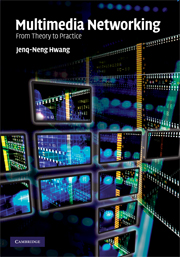Book contents
- Frontmatter
- Contents
- Preface
- Acknowledgements
- List of abbreviations
- 1 Introduction to multimedia networking
- 2 Digital speech coding
- 3 Digital audio coding
- 4 Digital image coding
- 5 Digital video coding
- 6 Digital multimedia broadcasting
- 7 Multimedia quality of service of IP networks
- 8 Quality of service issues in streaming architectures
- 9 Wireless broadband and quality of service
- 10 Multimedia over wireless broadband
- 11 Digital rights management of multimedia
- 12 Implementations of multimedia networking
- Index
7 - Multimedia quality of service of IP networks
Published online by Cambridge University Press: 26 January 2010
- Frontmatter
- Contents
- Preface
- Acknowledgements
- List of abbreviations
- 1 Introduction to multimedia networking
- 2 Digital speech coding
- 3 Digital audio coding
- 4 Digital image coding
- 5 Digital video coding
- 6 Digital multimedia broadcasting
- 7 Multimedia quality of service of IP networks
- 8 Quality of service issues in streaming architectures
- 9 Wireless broadband and quality of service
- 10 Multimedia over wireless broadband
- 11 Digital rights management of multimedia
- 12 Implementations of multimedia networking
- Index
Summary
Unlike stand-alone multimedia applications, in which the multimedia contents are originated and displayed on the same machine, multimedia networking has to enable multimedia data that originate on a source host to be transmitted through the IP networks (the Internet) and displayed at the destination host. The Internet, which uses IP protocols and packet switching, has become the largest network of networks in the world (it consists of a combination of many wide area and local area networks, WANs and LANs; see Figure 7.1. Multimedia over the Internet is fast growing among service providers and potential customers. Owing to the special requirements of audio and video perception, most existing and emerging real-time services need a high level of quality and impose great demands on the network. Real-time multimedia applications (e.g., live video streaming and video conferences), which are very sensitive to transmission delay and jitter and usually require a sufficiently high bandwidth, are a good example. To this end, various systems have been made available on network protocols and architectures to support the quality of service (QoS), such as the integrated services (IntServ) [22] [23] and differentiated services (DiffServ) [26] models. Multiprotocol label switching (MPLS) [21] is another technique often mentioned in the context of QoS assurance, but its real role in QoS assurance is not exactly the same as that of the IntServ and DiffServ models.
Layered Internet protocol (IP)
The IP protocol is the set (suite) of communications protocols that implement the protocol stack on which the Internet and most commercial networks run.
- Type
- Chapter
- Information
- Multimedia NetworkingFrom Theory to Practice, pp. 202 - 256Publisher: Cambridge University PressPrint publication year: 2009



